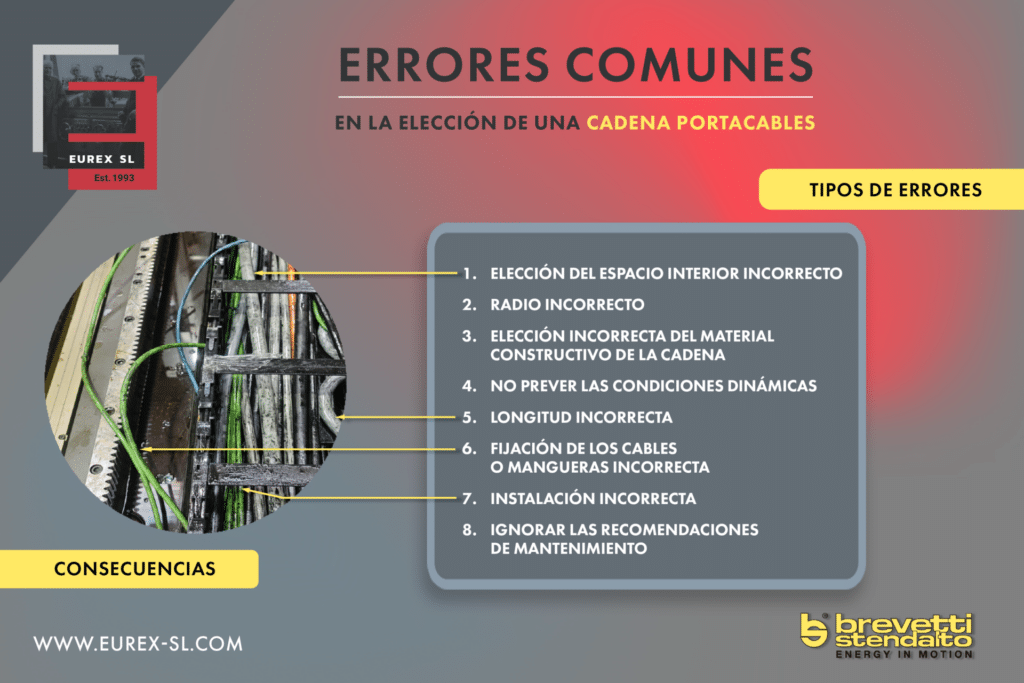La elección de la cadena portacables correcta es un paso crítico en la instalación de cualquier tipo de aplicación que requiera del uso de cables en movimiento y la protección de los mismos.
Cometer un error en la elección puede tener como consecuencia muy diversos problemas, como por ejemplo fallos operativos, daños en los cables o costosos tiempos de inactividad.
En Eurex estamos comprometidos en acompañarte en cada etapa del proceso para asegurar la elección adecuada de una cadena portacables. Desde la selección inicial hasta la instalación final, nos encargamos de guiarte y de que todo funcione a la perfección. A continuación, nos gustaría ofreceros en detalle los principales errores que se suelen cometer y que debemos evitar:
1. Elección del espacio interior incorrecto:
– Habitualmente sólo se tiene en consideración el diámetro del cable o manguera, y a partir de ahí se define la sección de la cadena.
– Debemos tener siempre en cuenta que el cable que vaya en el interior de la cadena portacables debe tener una holgura mínima de un 10% de su diámetro, mientras que la manguera (aceite, agua, aire, etc.) debe tener un 20%. Además, es necesario que la cadena y el cable estén separados para evitar roces y fricciones que provoquen desgastes.
2. Radio incorrecto:
– Los problemas derivados de la errónea elección del radio de curvatura de las cadenas portacables son muy frecuentes. La correcta elección del radio tiene que venir determinada por el cable o manguera que menos flexión permita. Esto es algo que demasiadas veces no se tiene en cuenta.
3. Elección incorrecta del material constructivo de la cadena:
– La elección del material adecuado para tu cadena portacables es fundamental para evitar fallos prematuros. Ignorar factores del entorno, como la temperatura, la presencia de químicos, humedad o abrasivos, puede llevar a la degradación prematura de la cadena.
– Existen diversos materiales para la confección de las cadenas: plástico o nylon, acero, acero inoxidable y aluminio.
– En Eurex sabemos que cada aplicación es única, por eso ofrecemos cadenas portacables en diversos materiales, como plástico, acero, acero inoxidable y aluminio, adaptados a las condiciones específicas de la aplicación.
4. No prever las condiciones dinámicas:
– No tener en cuenta la velocidad y aceleración puede causar problemas de rendimiento y durabilidad de la cadena portacables.
5. Longitud incorrecta:
– Es imprescindible tener en cuenta el curso que debe recorrer la cadena para definir el modelo adecuado.
6. Fijación de los cables o mangueras incorrecta:
– No fijar o fijar incorrectamente los cables o mangueras en uno o los dos extremos de una cadena portacables produce movimientos o desplazamientos continuos de las mismas, algo que acaba provocando desgastes y fatigas prematuros.
7. Instalación incorrecta:
– Una instalación incorrecta, como no fijar adecuadamente la cadena portacables o no seguir las recomendaciones del fabricante, puede llevar a problemas operativos.
8. Ignorar las recomendaciones de mantenimiento:
– No realizar un mantenimiento regular puede provocar un desgaste prematuro y fallos de la cadena portacables y, por ello, en la aplicación.
Evitar estos errores asegura una vida útil prolongada tanto de la cadena portacables como de los cables y mangueras que guía y protege, optimizando así la eficiencia, la seguridad y duración del sistema.

